Recent Issues
Vol.28/2 (2022, December)
Strategic Reliability Investments in Multi-Indenture Supply Chains
Author SANG-HYUN KIM
Keywords performance-based contracting, supply chain, incentives
Download
It has been documented that Performance-based contracting (PBC) promotes improvement of product reliability for maintenances of highvalued products. However, nontrivial challenges exist in a typical supply chain that consists of multiple suppliers providing services for distinct subsystems. We identify a source of inefficiency in this environment that leads the suppliers to underinvest in reliability. Using PBC neutralizes such inefficiency, but unexpectedly, it results in an overinvestments in reliability. Interestingly, long-term supply chain cost is reduced when PBC is combined with cost-sharing contracts, counter to the common belief that fixed-price contracts are more effective in reducing costs.
Vol.28/2 (2022, December)
The Effect of Supply Chain Integration on Supply Chain Risk Management Capability and Firm Performance in the Ppuri Industry
Author JAEWOOK JUNG, JAEHO SHIN, HONGSUK YANG
Keywords Ppuri industry, Supply chain integration, Supply chain risk management capability, Firm performance
Download
The Ppuri industry continues to stagnate as it is interlocked with other industries and lacks the ability to respond to environmental changes. Structural equation model is adopted to analyze the effect of supply chain integration on supply chain risk management capability and firm performance. Results demonstrate that external integration might not have a direct effect on firm performance, whereas internal integration can directly help improve financial performance. Although integration with suppliers does not turn out to directly affect firm performance, it can help improve supply chain risk management capability, which in turn positively affects firm performance.
Vol.28/2 (2022, December)
COVID-19 and Beyond: Implications on Supply Chain Network Design
Author MICHAEL K. LIM
Keywords COVID-19, supply chain disruption, robust network design, flexibility, agility, preparedness
Download
The unprecedented nature of the COVID-19 pandemic―the global scope, long-lasting impacts, and the simultaneous supply and demand disruptions―calls for a rethink of supply chain network design beyond what was studied in the literature. This study provides managerial insights on the design and operations of supply chain networks for the new normal. Building on the latest theoretical development in supply chain disruption and using an extensive simulation study based on the data of confirmed COVID-19 cases and lockdown measures, we analyze the dynamics of alternative supply chain network strategies under various pandemicinduced disruption scenarios. Our study highlights the principle of robustness, that a supply chain network should be designed to withstand alternative disruption scenarios that could emerge, which can be achieved through strategic design elements. We find that flexibility offers strategic redundancies to effectively combat the sources of uncertainty that trigger the forward and reverse bullwhip effects. In addition, we find that flexibility complemented with the strategies of preparedness and agility can be especially valuable in robust network. In particular, preparedness (securing emergency backup suppliers) is most effective when flexibility is deployed downstream; whereas, agility (proactive stocking policies in response to imminent disruptions) can be most helpful when flexibility is deployed upstream.
Vol.28/1 (2022, June)
Sabotage! Whistle-blowing Inside Family Firms During Succession Tournaments
Author JONGSUB LEE
Keywords Family Firms, Family Governance, Corporate Fraud, Succession Tournaments, Sibling Rivalry
Download
We document an unusual surge in fraud investigations for family firms with multiple sons who compete for leadership successions. Shareholders negatively react to the news, while such fraud investigations
are concentrated in firms run by families with extensive internal conflicts, leading to strong whistle-blowing incentives inside the family (i.e., sabotage). Using the sudden death of a chairman as an exogenous shock
that increases conflicts among potential heirs of the family firm, we find sharply increasing fraud investigations after the chair’s death. Overall, our results shed new light on the significant spillover from family governance to corporate governance in family-run organizations.
Vol.28/1 (2022, June)
Venture Capitalists in the Entrepreneurial Ecosystem and Fitness-reducing Competition
Author SEUNGYOUNG LEE, JONGHOON BAE
Keywords Entrepreneurship, Matching Failure, Agent-based Modeling, Partner Selection, Venture Capital
Download
Although the role of venture capital (VC) in entrepreneurship is undeniable, we address possible risks associated with the over-dependence of the ecosystem on VC firms. In particular, we examine whether the supply of VC promotes or undermines the creation of entrepreneurial value in a community even when VC firms serve as an effective selector of such value. With an agent-based model of entrepreneurship where entrepreneurs are uninformed of the capabilities of the potential business partners, we suggest that the local efficiency of VC firms in the matching process may lead to the information-cascade type of herding behavior among entrepreneurs, which undermines paradoxically the overall efficiency of the ecosystem. With this implication, we seek to contribute to the literature on entrepreneurship by highlighting the possibility that competition-promoting institutions may destabilize the market itself such that VC firms as the efficient selector of entrepreneurial opportunities may induce uninformed, non-VC-backed startups to imitate the investments of VC firms, thereby reducing the diversity of entrepreneurial activities and thus the stability of the entrepreneurial ecosystem.
Vol.28/1 (2022, June)
Informativeness of Peer Performance and Analyst Forecasts in Performance Target Setting
Author SUN-MOON JUNG, SEWON KWON, JAE YONG SHIN
Keywords Performance Target, Target Ratcheting, Relative Target Setting, Analyst Forecasts, Peer Performance
Download
Firms consider external information such as peer performance data and analyst forecasts when setting performance targets because this information provides relevant benchmarks about agents’ productivity. Using
the EPS targets of S&P 1500 firms from the 2006?2014 period, we examine whether firms’ reliance on certain benchmarks depends on the relative informativeness of the external information. We find that firms put greater weight on analyst forecasts than on peer performance information because their profitability is less likely to comove with that of their peer firms. We also find that the use of forecasts increases in settings where analyst forecasts are more informative regarding focal firms’ profitability.
Vol.27/2 (2021, December)
Does Analyst Coverage Encourage Firm Innovation? Evidence from Korea
Author WOOJIN KIM, YOONYOUNG CHOY
Keywords corporate venture capital, financial analysts, innovation, acquisition, R&D
Download
This paper examines whether analyst coverage affects firm innovation
in an economy dominated by family-controlled business groups. Using a
sample of Korean publicly traded firms from 2010 to 2018, we find that
an increase in financial analysts leads covered firms to cut investments
in corporate venture capital and R&D. Moreover, reduction in innovation
through acquisitions is more pronounced when analysts are from chaebol
(family-controlled large business group) affiliated brokerages. These findings
suggest that unlike in U.S., analyst coverage puts pressure on managers
to meet the analysts’ forecasts, thereby impeding innovation under such
environment.
Vol.27/2 (2021, December)
Information Uncertainty and Intraday Market Responses to Corporate Disclosures: A Study of the Korean Stock Market
Author BRYAN BYUNG-HEE LEE, DURI PARK
Keywords intraday market responses; corporate disclosures; information uncertainty
Download
Using market microstructure data, this study analyzes intraday market
responses to corporate disclosures subject to Regulation Fair Disclosure in
Korea and examines whether the intraday market responses are affected
by information uncertainty. We show that corporate news is incorporated
into stock prices in an efficient and timely manner. We further document
that positive stock returns and trading volume to good news disclosures are
stronger for firms with higher information uncertainty. Overall, our evidence
suggests that information uncertainty plays an important role in investors’
reactions to corporate disclosures.
Vol.27/2 (2021, December)
Auditors’ Response to Audit Fee Lowballing: The Change in Audit Hours and Hourly Audit Fees
Author SUNYOUNG PARK, EUGENIA Y. LEE, JONG-HAG CHOI
Keywords auditor change, lowballing, audit hours, hourly audit fees
Download
This study examines how lowballing auditors adjust audit hours and
hourly audit fees. Using Korean data, we first find that both lowballing
auditors and other auditors increase audit hours in the first year of an
audit engagement. However, only lowballing auditors charge lower hourly
audit fees in the initial year. The results suggest that lowballing auditors
charge low hourly fees to win a new audit contract while exerting more
effort to maintain an appropriate level of audit quality. Our findings
mitigate regulators’ concern that lowballing auditors would reduce effort
and sacrifice audit quality to attract new contracts.
Vol.27/1 (2021, June)
Overproduction, Aggregate Accounting Performance, and Gross Domestic Product
Author Bjorn N. Jorgensen, Yonggyu Lee, and Hyungil Oh
Keywords Overproduction, Aggregate earnings, Gross domestic product (GDP)
Download
This paper explores possible links between overproduction and future gross domestic product (GDP) growth. Using a measure of economywide overproduction that captures firms’ real earnings management (REM) incentives, we find that REM-driven overproduction has a negative moderating effect on the positive association between growth in aggregate accounting performance and one-quarter-ahead GDP growth documented in the literature. We also find that macro forecasters do not fully incorporate this effect into their forecasts. Our findings contribute primarily to the literature that links aggregate accounting information to GDP growth.
Seoul Journal of Business

ISSN 1226-9816 (Print)
ISSN 2713-6213 (Online)
ISSN 2713-6213 (Online)


